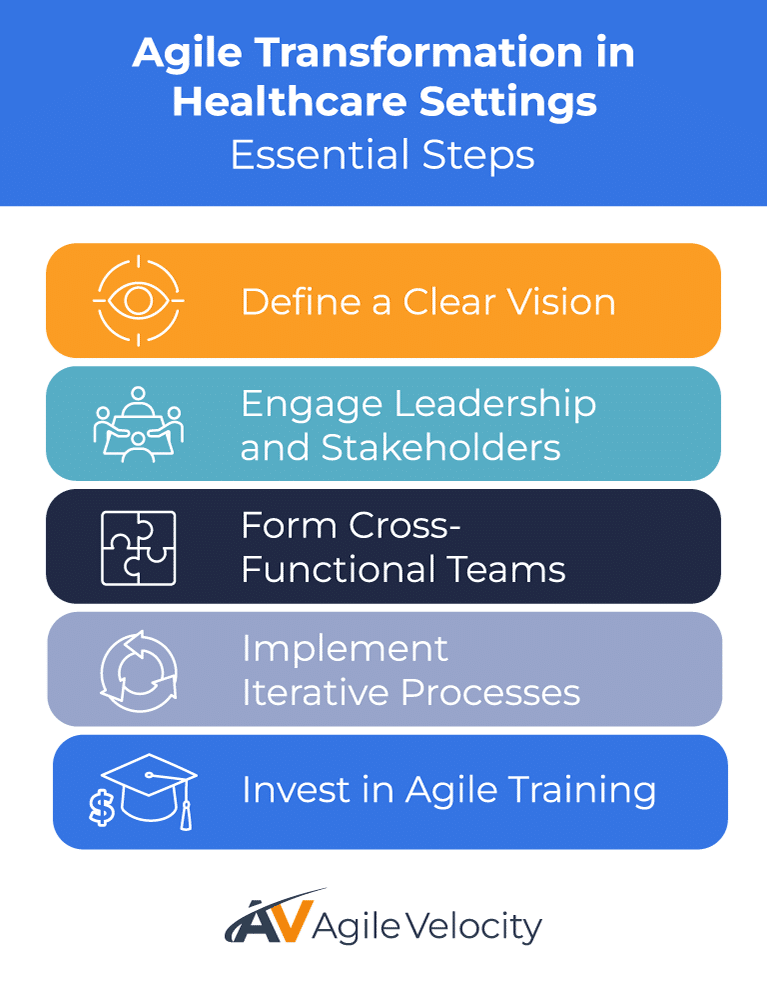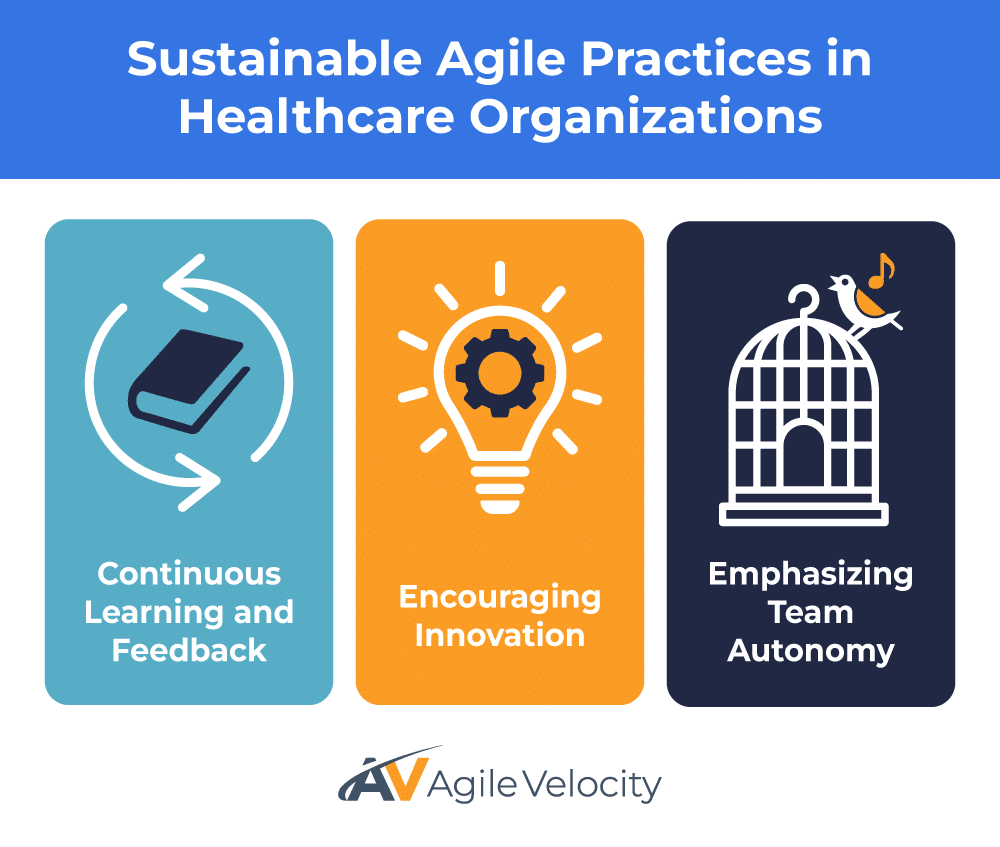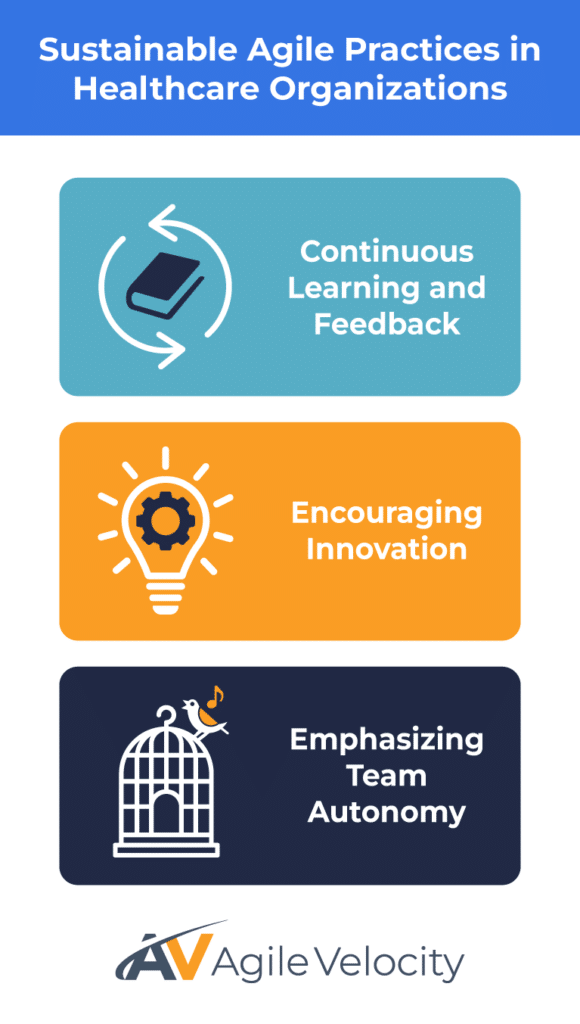In today’s rapidly evolving healthcare landscape, organizations face unprecedented challenges. From adapting to new technologies to navigating complex regulatory requirements, the need for Agile Transformation has never been greater. Agile Transformation offers a pathway for healthcare organizations to meet these challenges head-on, empowering them to improve patient care, enhance operational efficiency, and foster a culture of continuous improvement.
This article explores how healthcare leaders can leverage Agile to revolutionize their operations. We’ll explore practical strategies, tools, and practices that can help healthcare providers stay ahead in a dynamic environment. Whether you’re a healthcare executive, an IT leader, or a professional interested in innovative organizational practices, read on to discover how Agile Transformation can empower your organization for success.
Agile in Healthcare Transformation
What Is Agile in Healthcare?
Agile Transformation originates from Agile, which were initially developed for software development to increase flexibility, collaboration, and responsiveness to change. In healthcare, Agile Transformation refers to adopting these principles to enhance processes, improve patient outcomes, and respond effectively to the ever-changing healthcare environment. Agile in healthcare emphasizes iterative progress, cross-functional teamwork, and the ability to adapt quickly to new information and circumstances.
The Importance of Agility in Addressing Healthcare Challenges
Healthcare organizations operate in environments where regulations frequently change, technologies evolve rapidly, and patient needs are constantly shifting. Agility enables healthcare providers to:
- Respond Quickly to Change in regulations, technology, and patient expectations with ease.
- Improve Patient Care through patient-centric approaches that enhance outcomes and satisfaction.
- Enhance Collaboration to break down silos and promote cross-functional teamwork among healthcare professionals.
- Increase Operational Efficiency by streamlining processes to reduce waste and optimize resource utilization.
Key Benefits of Agile Transformation in Healthcare
Aligning healthcare organizational goals with Agile principles involves prioritizing patient value, encouraging collaboration, and embracing change. By embracing Agile Transformation, healthcare organizations can achieve:
- Enhanced Proactivity: Shift from reactive to proactive care, anticipating patient needs before they arise.
- Decentralization and Empowerment: Empower frontline staff to make real-time decisions, improving efficiency.
- Continuous Improvement: Foster a culture where teams regularly reflect and improve upon their practices.
- Psychological Safety: Create environments where staff feel safe to express concerns and ideas, leading to innovation.
- Empowerment and Accountability: Agile fosters team ownership and accountability, driving performance and innovation.
Key Agile Transformation Steps Steps for Healthcare
Agile Transformation in healthcare is a strategic approach aimed at reshaping operations to meet the constantly evolving demands of the industry. By embracing Agile, healthcare organizations can improve how they deliver patient care, manage resources, and adapt to regulatory and technological changes. This transformation focuses on being flexible and responsive, ensuring organizations stay competitive and adaptable in a dynamic environment. By leveraging Agile, healthcare can lead initiatives that result in better patient outcomes, optimized processes, and an innovative work culture. Let’s explore the essential steps needed to implement Agile Transformation effectively in healthcare settings.
- Define a Clear Vision: Establish what Agile success looks like for your organization, focusing on patient care and operational goals.
- Engage Leadership and Stakeholders: Ensure commitment from all levels, including executives, managers, and frontline staff.
- Form Cross-Functional Teams: Create teams that include diverse roles to foster collaboration and comprehensive problem-solving.
- Implement Iterative Processes: Adopt cycles of planning, acting, and reviewing to encourage adaptability.
- Invest in Agile Training to equip your teams with the necessary skills and knowledge.
Implementing Lean Portfolio Management to Optimize Healthcare Operations
Lean Portfolio Management (LPM) helps align projects and initiatives with your organization’s strategic goals. In healthcare, LPM can:
- Optimize Resource Allocation: Ensure that time, money, and personnel are invested in high-impact areas.
- Enhance Decision-Making: Provide transparency and data-driven insights to make informed choices.
- Increase Agility: Enable swift adaptation to changing priorities and emerging needs.
Enhancing Decision-Making Processes Through Agile
- Decentralize Decisions: Empower teams to make decisions quickly without excessive bureaucracy.
- Continuous Feedback Loops: Implement regular check-ins and reviews to adjust strategies in real time.
- Visual Management Tools: Use dashboards and boards to visualize work progress and bottlenecks.
Role of Agile Coaching in Healthcare
Agile Coaches support teams by:
- Facilitating Workshops: Conduct sessions on Agile practices like Scrum Events and Kanban flow.
- Mentoring Staff: Guide individuals in adopting new behaviors and mindsets.
- Building Competency: Strengthen the organization’s internal capabilities to sustain Agile practices.
Impact of Coaching on Healthcare Teams and Their Performance
- Improved Collaboration: Teams communicate more effectively and work cohesively.
- Increased Adaptability: Staff become more comfortable with change and uncertainty.
- Enhanced Performance: Regular coaching leads to higher productivity and better patient care outcomes.
Leveraging Agile Tools and Practices in Healthcare
Agility is not just about adopting a methodology; it’s about utilizing tools and practices that enhance the healthcare process and outcomes. In this section, we delve into the specific Agile tools and techniques that healthcare organizations can employ to transform their operations. From using visual management tools for tracking progress to implementing continuous feedback systems for improving care, these practices facilitate quicker decision-making, enhance team collaboration, and increase efficiency. By integrating these Agile tools, healthcare providers can remain responsive and innovative, ultimately leading to better patient care and streamlined operations.
Incorporating SAFe® in Healthcare
Benefits of SAFe®
The SAFe® framework is designed to scale Agile practices across large organizations. Benefits for healthcare include:
- Unified Vision: Aligns all teams towards common goals and objectives.
- Improved Coordination: Enhances collaboration between different departments and disciplines.
- Accelerated Innovation: Speeds up the delivery of new services and improvements.
Steps for Integration
- Train Teams in SAFe®: Provide education on SAFe principles and practices.
- Establish Agile Release Trains (ARTs): Organize teams around value streams for efficient delivery.
- Implement Planning Intervals (PIs): Use regular planning sessions to synchronize efforts and set priorities.
Utilizing AI Solutions Alongside Agile Strategies
Integration of AI to Enhance Operational Efficiency and Patient Outcomes
- Automation of Routine Tasks with AI: Use AI to handle administrative work, allowing staff to focus on patient care.
- Predictive Analytics: Leverage AI to anticipate patient needs and optimize resource allocation.
- Remote Patient Monitoring: Employ AI-powered tools to track patient health in real time, reducing hospital readmissions.
Synergy Between AI and Agile
Combining AI solutions with Agile Transformation strategies enables enhanced decision-making and faster adjustments to care plans. According to Forbes, this fusion empowers teams to respond adeptly to market dynamics and stakeholder needs.
How Path to Agility® Navigator Facilitates Healthcare Transformation
Path to Agility Navigator provides a structured approach to guide organizations through their Agile Transformation. It helps healthcare providers to:
- Visualize Transformation: Identify specific areas needing change and understand the roadmap ahead.
- Track Progress: Monitor advancements towards goals and adjust strategies as needed.
- Define Next Steps: Prioritize actions that will have the most significant impact on performance.
- Assess Organizational Maturity: Evaluate current Agile practices and identify gaps.
- Customize Transformation Paths: Create tailored plans based on unique organizational needs.
- Engage Teams: Involve staff at all levels in the transformation process for greater buy-in and success.
- Facilitate Communication: It streamlines communication between different departments, ensuring that everyone is aligned and informed throughout the transformation process.
Implementing Agile Training Programs in Healthcare
Importance of Agile Training for Healthcare Professionals
- Builds Capability: Equips staff with the skills to participate in Agile practices effectively.
- Encourages Engagement: Training fosters a sense of ownership and commitment to transformation efforts.
- Supports Change Management: Smooths the transition by reducing resistance and increasing understanding.
Types of Agile Training and Their Applications in Healthcare
- Certification Programs: Courses leading to recognized qualifications like Certified ScrumMaster®
- Custom Workshops: Tailored sessions focusing on specific needs, such as Lean Portfolio Management.
- Online Learning: Flexible options that allow staff to learn at their own pace.
Benefits of Certification and Ongoing Education
- Professional Development: Enhances career prospects and job satisfaction.
- Organizational Excellence: Certified staff can mentor others, spreading expertise throughout the organization.
- Adaptation to Trends: Keeps teams updated on the latest methodologies and industry best practices.
Practical Approaches to Adopting Agile in Healthcare Settings
Embracing Agile in healthcare settings is a transformative journey that requires careful consideration of unique organizational dynamics and the specific challenges of the healthcare industry. This section outlines practical approaches to implementing Agile in healthcare, offering a roadmap for healthcare leaders eager to unlock new levels of flexibility and efficiency.
By focusing on real-world applications, healthcare organizations can integrate Agile practices that enhance patient care, improve collaborative efforts amongst staff, and streamline operational processes. From prioritizing patient value to fostering a culture of continuous improvement, these strategies are designed to meet the dynamic needs of the healthcare landscape, resulting in improved patient outcomes and operational excellence.
Transitioning from Traditional Methods to Agile Approaches
- Assess Current Practices: Understand your starting point to identify areas for improvement.
- Engage a Pilot Team: Start with a small group to test Agile practices before scaling up.
- Communicate Transparently: Keep lines of communication open to address concerns and share successes.
Fostering a Culture of Continuous Improvement and Collaboration
- Implement Regular Retrospectives: Encourage teams to reflect and identify improvement opportunities.
- Promote Cross-Functional Teams: Break down departmental barriers to enhance communication and problem-solving.
- Reward Innovation: Recognize and incentivize ideas that lead to better patient care.
Addressing Regulatory and Technological Changes Using Agile Practices
- Stay Informed: Keep abreast of regulatory updates and integrate them into Agile planning.
- Embrace Flexibility: Use Agile’s iterative approach to adjust processes without significant disruptions.
- Collaborate with Compliance: Involve regulatory experts in planning to ensure adherence to requirements.
Overcoming Barriers to Agile Adoption in Healthcare
Identification of Common Obstacles and Resistance Points
- Cultural Resistance: Staff may be hesitant to change longstanding practices.
- Lack of Understanding: Misconceptions about Agile can hinder adoption.
- Resource Limitations: Budget constraints may affect training and tool availability.
Strategies to Gain Buy-In from Key Stakeholders and Team Members
- Educate Leadership: Demonstrate the value of Agile through evidence and case studies.
- Highlight Benefits: Share success stories and potential improvements in patient care.
- Involve Teams Early: Engage staff in planning to increase ownership and reduce resistance.
Managing Risks and Ensuring Accountability Within Agile Frameworks
- Define Clear Roles: Ensure everyone understands their responsibilities.
- Set Measurable Goals: Establish KPIs to track progress and outcomes.
- Provide Support Systems: Offer resources and assistance to teams as they adapt.
Measuring Success and Evaluating Impact
Identifying Key Performance Indicators for Agile Success in Healthcare
- On-Time Delivery: Assess whether projects and initiatives meet deadlines.
- Quality of Care: Monitor patient satisfaction and health outcomes.
- Employee Engagement: Evaluate staff morale and retention rates.
- Operational Metrics: Track efficiency improvements like reduced wait times or cost savings.
Techniques for Tracking the Progress and Impact of Agile Initiatives
- Data Analytics: Use metrics and dashboards to visualize performance.
- Regular Check-Ins: Conduct Daily Scrum Events and Sprint Reviews to monitor progress.
- Feedback Surveys: Gather input from patients and staff to inform improvements.
Adjusting Agile Strategies Based on Outcomes and Feedback
- Iterative Improvements: Use Retrospective Events to refine practices.
- Responsive Planning: Adapt goals and processes based on real-time data.
- Continuous Learning: Encourage ongoing education to keep up with best practices.
Sustainable Agile Practices in Healthcare Organizations
Building Long-Term Agility
To ensure that Agile Transformation delivers lasting benefits, healthcare organizations must focus on sustainable practices. This involves continuous learning, regular updates to Agile based on feedback, and maintaining a flexible mindset across all levels of the organization. Additionally, fostering leadership that champions Agile principles is crucial for sustaining momentum and ensuring that agility becomes ingrained in the organizational culture.
Encouraging Innovation
Sustainability in Agile means fostering an environment where innovation thrives. By encouraging teams to experiment with new ideas and approaches, healthcare providers can continuously improve their services and adapt to emerging healthcare trends and technologies. This proactive stance on innovation ensures that healthcare organizations remain at the forefront of industry advancements and can swiftly integrate new technologies.
Develop Team Autonomy
Develop a structure where teams have the freedom to make decisions relevant to their work. This autonomy allows them to innovate, test, and adapt processes independently, fostering a sense of ownership and accountability. By decentralizing decision-making, organizations can speed up response times and cultivate a more resilient and adaptable workforce.
Streamlining Agile Practices for Maximum Impact
Combining Empowerment and Accountability
To avoid redundancy and streamline processes, it’s essential to combine similar Agile principles. For example, Empowerment and Accountability can be merged to emphasize that empowering teams inherently increases their accountability. This streamlined approach ensures that teams are both autonomous and responsible, driving performance without overlapping concepts.
Enhancing Cross-Functional Collaboration
Enhancing collaboration between departments is a cornerstone of Agile Transformation. By fostering cross-functional teams, healthcare organizations can ensure that all perspectives are considered, leading to more comprehensive and effective solutions. This collaboration not only improves processes but also builds a stronger, more cohesive organizational culture.
Simplifying Complex Agile Concepts
Understanding Scrum Events
To make Agile more approachable, it’s important to simplify complex concepts like Scrum Events. Scrum Events include:
- Sprint Planning: A session where teams plan the work to be completed in the upcoming sprint.
- Daily Scrum: A short, daily event where team members discuss progress and obstacles.
- Sprint Review: An event to review the completed work and gather feedback.
- Sprint Retrospective: A session for teams to reflect on the sprint and identify areas for improvement.
Explaining Kanban Flow
Kanban Flow refers to the visual management of work using a Kanban Board, which helps teams track progress and identify bottlenecks. By limiting Work In Progress (WIP) Limits, teams can reduce multitasking and improve focus, leading to increased efficiency and better quality outcomes.
Lean Portfolio Management Simplified
Lean Portfolio Management aligns projects with organizational goals, ensuring that resources are allocated effectively. In healthcare, LPM helps prioritize initiatives that have the most significant impact on patient care and operational efficiency, facilitating smarter decision-making and strategic investment, as discussed in the International Journal of Environmental Research and Public Health.
Revolutionize Your Healthcare Organization for a Brighter Future

Agile Transformation is more than just a shift in processes—it’s a fundamental change in how healthcare organizations think and operate. By adopting Agile methodologies, healthcare providers can enhance patient care, improve operational efficiency, and remain adaptable in a constantly changing environment.
Embracing Agile empowers teams, fosters collaboration, and cultivates innovation. Tools like Path to Agility Navigator and frameworks like SAFe® provide the guidance needed to navigate this transformation successfully.
At Agile Velocity, we’re here to support your journey towards organizational agility. Our expertise in Agile Transformation can help you visualize change, track progress, and define actionable steps. Let’s partner together to achieve your goals and empower your healthcare organization for success.







